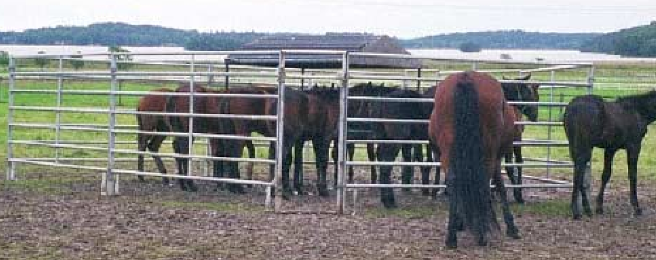“Some mares don’t provide enough milk to meet sufficient nutrient requirements of their foals.”
Those babies often need access to solid foods.
“Creep feeding foals provides nutrients for sound bone and muscle growth,” said Kris Hiney, Oklahoma State University Extension equine specialist. It also will lessen weaning stress, she added.

“Consumption of creep feed is extremely variable between foals,” Hiney said.
“Most creep rations should be balanced to contain about 16 percent crude protein, with calcium and phosphorous,” Hiney pointed out.
Copper, zinc, iron, selenium, vitamin E and amino acids such as lysine also are important.
“Rations should include high-quality protein sources such as alfalfa meal, soybean meal or milk protein,” Hiney said. “They can be fed as pellets or as coarsely processed grains.”
A three-month-old foal can consume three pounds of a palatable feed per day, plus milk and pasture or hay. A foal will consume about 3-percent of its body weight in dry matter to gain more than two-pounds each day.
“Foals will regulate their individual needs by consuming feed frequently throughout the day when fed free choice,” Hiney said.
The exact type of creep feeder needed will depend on the facilities in which the mares and foals are kept. “Commercially manufactured creep feeders are available, though horse owners may prefer to build their own,” Hiney said.
A small pen that allows entry to a foal but through which a mare cannot fit will make a suitable creep feeder.
“Creep feeders should be designed so the openings are low enough in height to limit access by mares,” Hiney explained. Still, it should be at least a couple of inches above the wither height of the foals.
“A creep feeder needs to be quite sturdy to prevent a determined mare from pushing her way in,” Hiney said. “They can still crawl in if the feeder only limits mares by height.”
As foals grow, the height opening will need to be adjusted. The width of the opening also should allow for at least several inches of clearance from the foal’s body.
“A foal should be able to enter, eat, turn around and exit with no difficulty,” Hiney said. Sixty-square-feet should be adequate to accommodate one or two foals.
“If a feeder is for multiple foals, then an exit is necessary so a foal doesn’t become trapped inside,” Hiney recommended.
“If the horse manager is feeding free choice, take care to provide enough feed for a timid foal. Otherwise, a more dominant foal could consume all the grain,” Hiney said. “Unlimited resources are not guarded as fiercely. Be sure to provide fresh feed and keep the feeders clean.”
Feeders designed for stalls where mares are fed individually may be more practical for horse owners. “The bars of such feeders are spaced so that the mare’s muzzle won’t fit inside,” Hiney said.
Regardless of the type of creep feeder used, it should be near a place frequented by the mare. “Where mama goes, the foal typically will want to follow,” Hiney said.